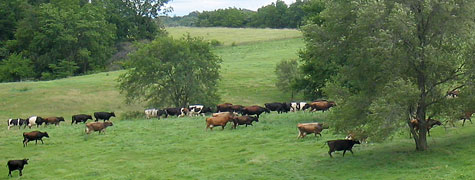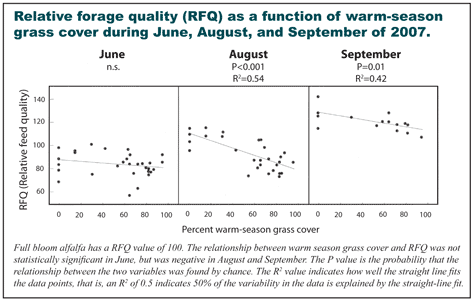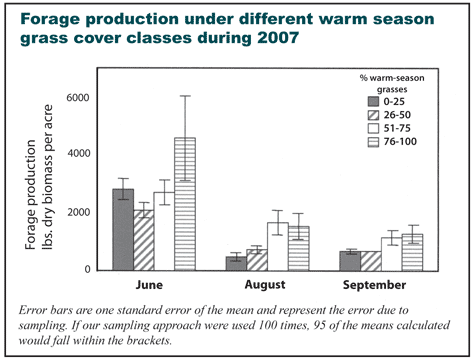Tradeoffs in ecosystem services using warm-season grasses in managed pastures (Research Brief #78)

Printer-friendly version (PDF)
Farms provide the food, fiber and energy that people need. Farms also benefit society by providing services that may not earn money, but support functioning of the ecosystem (read more about ecosystem services below). For instance, farms can provide carbon sequestration, water purification and wildlife habitat. The extent to which they provide these services depends on their management. Increasingly, society is considering paying farmers for services that regulate climate or purify water. For instance, developing carbon markets might pay farmers for practices that sequester carbon in soils.
Most graziers in the Upper Midwest use non-native cool-season grasses because they are very productive and their forage quality is relatively high. Many farmers are interested in using warm-season grasses native to the tallgrass prairie for forage because of an interest in native plants, and because these grasses use water and nutrients more efficiently than cool-season grasses. In Wisconsin, tallgrass prairie once covered over two million acres, but less than one percent of that native prairie remains today. Incorporating native, warm-season grasses into cool-season pastures offers a compromise between complete restoration
and no native species in the landscape.
Compared to cool-season pasture, warm-season native grasses can potentially:
- Balance forage production during hot summer months (provisioning service—see below)
- Restore native plants to the land (cultural service)
- Increase soil carbon sequestration (regulating and supporting services)
- Enhance wildlife habitat (regulating and supporting services)
- Promote land stewardship (cultural service)
Two on-farm studies by researchers Randy Jackson, Julie Woodis, Herika Kummel and Emma Bouressa from UW-Madison examined techniques for increasing warm-season grasses in Wisconsin pastures and assessed some of the tradeoffs inherent in using these grasses. The first study tested the establishment of native, warm-season grasses into existing cool-season pastures. The second study investigated different mixtures of warm-season and cool-season grasses that had been established for over ten years. These studies were supported by the USDA Sustainable Agriculture Research and Education program, the UW-Madison Center for Integrated Agricultural Systems and the Grazing Lands Conservation Initiative.
Warm-season grass management
The first study took place at a beef farm in Iowa County, Wisconsin from 2004 to 2007. In 2004, seed of three native, warm-season grasses—big bluestem (Andropogon gerardii), switchgrass (Panicum virgatum) and indiangrass (Sorghastrum nutans)—were no-till drilled into an existing pasture dominated by non-native, cool-season grasses, legumes and forbs. Experimental plots were either spring burned or rotationally grazed from 2004 through 2006. The grazed plots were grazed one day per month throughout each of the growing seasons. In 2007, a third treatment of combined burning and grazing was introduced. Researchers measured warm-season grass density, forage production, forage quality, root production and other indicators of pasture productivity under these three treatments. Root turnover was not measured.
Results from the 2007 growing season showed that burning promoted greater native grass abundance and root production, while grazing promoted greater forage production. This is not to say that there was not significant root production under managed grazing, simply that it was greater with annual burning. As the density of native, warm-season grasses increased, there was no change in forage quality in spring and summer, but a slight decrease in fall (data not shown).
Forage production
The second study took place in 2007 at two Wisconsin locations: a bison farm in Marquette County and the Wisconsin Integrated Cropping System Trials (WICST) at the Arlington Agricultural Research Station in Columbia County. Warm-season grasses were established in the pastures at both sites in 1999 as prairie restorations. Cool-season grasses had re-colonized to varying degrees on each site. Experimental plots were clipped periodically throughout the growing season (every four to eight weeks) to approximate the effects of managed grazing. Fifteen 19.7 × 19.7-in plots were used at each site to estimate native, warm-season grass abundance and to relate forage production and quality to varying ratios of warm- to cool-season grasses. Data from both sites were combined.
Results from this study showed that as native, warm-season grasses increased, forage quality was reduced in August and September and forage production was greater (see figures).
Tradeoffs in ecosystem services
When farmers decide to introduce warm-season grasses into their pastures, whether to enhance carbon sequestration through root production or to re-introduce native plants, they potentially sacrifice forage quality. Whether this tradeoff is worthwhile to farmers is a question of public policy. Historically, financial incentives have promoted maximizing production services, but future policies may promote other ecosystem services. Weighing the possible agricultural and ecological tradeoffs of farm management decisions informs policymakers and farmers.
For more information, contact:
Randy Jackson, UW-Madison Agronomy Department,
608-261-1480, rdjackson@wisc.edu
What are ecosystems services?
Farms provide a range of costs and benefits to society. The ecosystem services framework shown below classifies the services provided by farms.
Ecosystem services are the benefits provided by ecosystems that promote human well-being. These services fall under four categories:
Provisioning services – products obtained from ecosystems (examples: food, fiber, fuel)
Regulating services – benefits obtained from the regulation of ecosystem processes (examples: flood control, disease control, climate stabilization)
Cultural services – nonmaterial benefits that people obtain from ecosystems (examples: spiritual, recreational, educational)
Supporting services – phenomena necessary for all other ecosystem services (examples: nutrient cycling, primary production, soil formation)
Source: Millennium Ecosystem Assessment, 2005. Ecosystems and Human Well-being: Synthesis. Island Press, Washington, DC.
This kind of ecosystem services framework can be complex, but it has the potential to clarify which services are being promoted under specific management scenarios. For example, applying nitrogen fertilizer can stimulate forage production, which is a provisioning service. But this benefit can be weighed against a change in a supporting service such as soil nutrient loss that may decrease water quality in a region.
Contact CIAS for more information about this research.
Published as Research Brief #78
January, 2009



